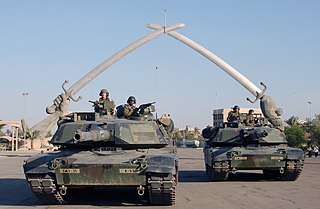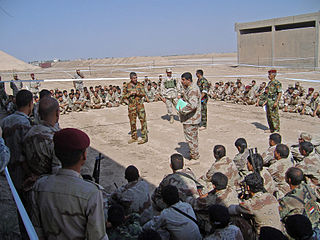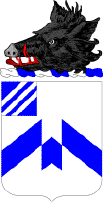
The following is a timeline of major events during the Iraq War, following the 2003 invasion of Iraq.

An Iraqi insurgency began shortly after the 2003 American invasion deposed longtime leader Saddam Hussein. It is considered to have lasted until the end of the Iraq War and U.S. withdrawal in 2011. It was followed by a renewed insurgency.

After the 2003 invasion of Iraq was completed and the regime of Saddam Hussein was toppled in May 2003, an Iraqi insurgency began that would last until the United States left in 2011. The 2003–2006 phase of the Iraqi insurgency lasted until early 2006, when it escalated from an insurgency to a Sunni-Shia civil war, which became the most violent phase of the Iraq War.

After the handover of sovereignty, Operation Squeeze Play was a combined U.S./Iraqi sweep of the western suburbs of Baghdad launched on 22 May 2005. Almost 300 suspects were detained in the first day of the operation.
Soldiers from the U.S. 1st Armored Division's 3rd Brigade Combat Team struck at insurgent elements in the Al Mansor district on the west side of Baghdad on 7 December 2003, according to U.S. Central Command officials.

The Battle of Al-Qa'im was a military offensive conducted by the United States Marine Corps, against insurgent positions in Iraq's northwestern Anbar province, which ran from 8 May 2005 to 19 May 2005. It was focused on eliminating insurgents and foreign fighters in a region known as a smuggling route and a sanctuary for foreign fighters.
Operation Together Forward, also known as Forward Together, was an unsuccessful offensive against sectarian militias in Baghdad to significantly reduce the violence in which had seen a sharp uprise since the mid-February 2006 bombing of the Askariya Mosque, a major Shiite Muslim shrine, in Samarra.
The Karbala provincial headquarters raid was a special operation carried out on January 20, 2007, by the Asa'ib Ahl al-Haq against the U.S. contingent of the Joint Security Station, located within the Iraqi Police headquarters. The assault, which left five U.S. soldiers dead and three wounded, has been called the "boldest and most sophisticated attack in four years of warfare" and is furthermore notable for being one of the few instances when any sort of militants or insurgents have actually managed to capture U.S. soldiers since the Vietnam War.

Operation Imposing Law, also known as Operation Law and Order, Operation Fardh al-Qanoon or Baghdad Security Plan (BSP), was a joint Coalition-Iraqi security plan conducted throughout Baghdad. Under the Surge plan developed in late 2006, Baghdad was to be divided into nine zones, with Iraqi and American soldiers working side by side to clear each sector of Shiite militias and Sunni insurgents and establish Joint Security Stations so that reconstruction programs could begin in safety. The U.S. military commander in Iraq, David Petraeus, went so far as to say Iraq would be "doomed" if this plan failed. Numerous members of Congress stated the plan was a critical period for the U.S. presence in Iraq.

The Battle of Baqubah II took place during the Iraq War in the capital of the Iraqi province Diyala, to the north-east of Baghdad. It began in early March 2007, when U.S. and Iraqi forces commenced preliminary operations to "establish a presence in Diyala beyond their Forward Operating Base".

Operation Phantom Thunder began on 16 June 2007, when Multi-National Force-Iraq launched major offensive operations against al-Qaeda and other extremist terrorists operating throughout Iraq. It was the largest coordinated military operation since the 2003 invasion of Iraq. Operation Phantom Thunder was a corps level operation, including Operation Arrowhead Ripper in Diyala Province, Operation Marne Torch and Operation Commando Eagle in Babil Province, Operation Fardh al-Qanoon in Baghdad, Operation Alljah in Anbar Province, and continuing special forces actions against the Mahdi Army in southern Iraq and against Al-Qaeda leadership throughout the country. The operation was one of the biggest military operations in Iraq since the U.S. invasion in 2003.

Operation Commando Eagle was a 2007 military operation of the Iraq War. It began on 21 June 2007, when Iraqi and Coalition forces launched a combined ground and air assault operation against al-Qaeda and other extremist terrorists operating in the Mahmudiyah region of Babil province. The action was intended to curb terrorist activity southwest of Baghdad through a mix of helicopter assaults and Humvee-mounted movements.

Operation Marne Torch refers to two operations launched by U.S.-led Coalition forces in 2007 against al-Qaeda in Iraq in the Arab Jabour area of Babil province. This campaign is named after Operation Torch, the joint US/British invasion of French North Africa in 1942, presumably because of the two operations' similar thrust into the enemies' southern underbellies.
Operation Stampede 3 was a U.S. military operation conducted in Baghdad, Iraq, in July 2007 to try to correct the security situation.

Operation Phantom Strike was a major offensive launched by the Multi-National Corps – Iraq on 15 August 2007 in a crackdown to disrupt both the al-Qaeda-affiliated Islamic State of Iraq and Shia insurgent operations in Iraq. It consisted of a number of simultaneous operations throughout Iraq focused on pursuing remaining ISI terrorists and Iranian-supported insurgent groups. It was concluded in January 2008 and followed up with Operation Phantom Phoenix.
The Ramadan Offensive refers to the attacks mounted by insurgents in Iraq during the holy Muslim month of Ramadan in 2006, three years after the original Ramadan Offensive.

The 30th Infantry Regiment is a United States Army infantry regiment. It was originally constituted 2 February 1901 in the Regular Army as the 30th Infantry. It was organized 12 February – 19 August 1901 at Fort Logan, Colorado, at the Presidio of San Francisco, California, and in the Philippines.
Operation Phantom Phoenix was a major nationwide offensive launched by the Multinational Force Iraq (MNF-I) on 8 January 2008 in an attempt to build on the success of the two previous corps-level operations, Operation Phantom Thunder and Operation Phantom Strike and further reduce violence and secure Iraq's population, particularly in the capital Baghdad. The offensive consisted of a number of joint Coalition and Iraqi Army operations throughout northern Iraq as well as in the southern Baghdad Belts.
The 2008 Nineveh campaign was a series of offensives and counter-attacks between insurgent and Coalition forces for control of the Nineveh Governorate in northern Iraq in early-to-mid-2008. Some fighting also occurred in the neighboring Kirkuk Governorate.
The Baghdad Belts are the residential, agricultural and industrial areas, as well as communications and transportation infrastructure that encircle the Iraqi capital and connect it to other areas in Iraq. In the Iraq War, they were used by insurgents as staging points for operations in the capital.











